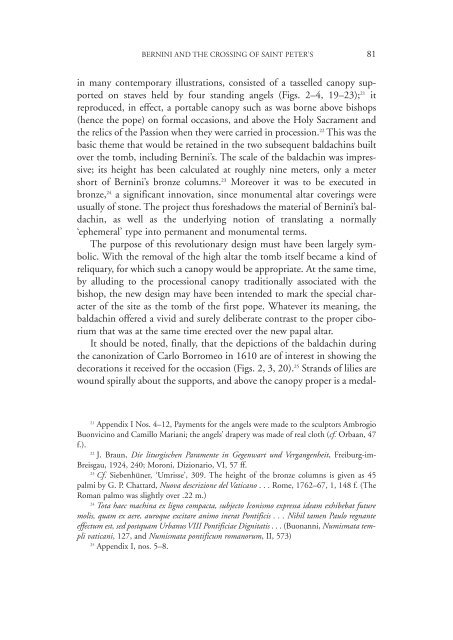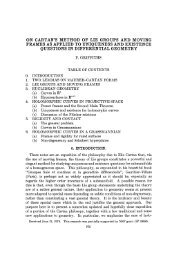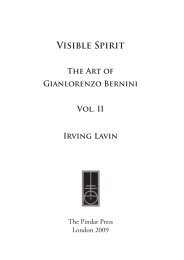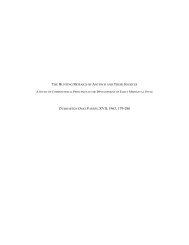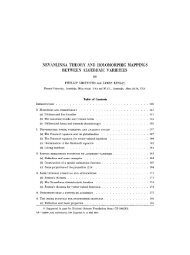Visible Spirit The Art of Gianlorenzo Bernini Vol. I Irving Lavin
Visible Spirit The Art of Gianlorenzo Bernini Vol. I Irving Lavin
Visible Spirit The Art of Gianlorenzo Bernini Vol. I Irving Lavin
You also want an ePaper? Increase the reach of your titles
YUMPU automatically turns print PDFs into web optimized ePapers that Google loves.
<strong>Lavin</strong> IV. Revised:CHAPTER 2.qxd 13/8/07 07:25 Page 21<br />
BERNINI AND THE CROSSING OF SAINT PETER’S 81<br />
in many contemporary illustrations, consisted <strong>of</strong> a tasselled canopy supported<br />
on staves held by four standing angels (Figs. 2–4, 19–23); 21 it<br />
reproduced, in effect, a portable canopy such as was borne above bishops<br />
(hence the pope) on formal occasions, and above the Holy Sacrament and<br />
the relics <strong>of</strong> the Passion when they were carried in procession. 22 This was the<br />
basic theme that would be retained in the two subsequent baldachins built<br />
over the tomb, including <strong>Bernini</strong>’s. <strong>The</strong> scale <strong>of</strong> the baldachin was impressive;<br />
its height has been calculated at roughly nine meters, only a meter<br />
short <strong>of</strong> <strong>Bernini</strong>’s bronze columns. 23 Moreover it was to be executed in<br />
bronze, 24 a significant innovation, since monumental altar coverings were<br />
usually <strong>of</strong> stone. <strong>The</strong> project thus foreshadows the material <strong>of</strong> <strong>Bernini</strong>’s baldachin,<br />
as well as the underlying notion <strong>of</strong> translating a normally<br />
‘ephemeral’ type into permanent and monumental terms.<br />
<strong>The</strong> purpose <strong>of</strong> this revolutionary design must have been largely symbolic.<br />
With the removal <strong>of</strong> the high altar the tomb itself became a kind <strong>of</strong><br />
reliquary, for which such a canopy would be appropriate. At the same time,<br />
by alluding to the processional canopy traditionally associated with the<br />
bishop, the new design may have been intended to mark the special character<br />
<strong>of</strong> the site as the tomb <strong>of</strong> the first pope. Whatever its meaning, the<br />
baldachin <strong>of</strong>fered a vivid and surely deliberate contrast to the proper ciborium<br />
that was at the same time erected over the new papal altar.<br />
It should be noted, finally, that the depictions <strong>of</strong> the baldachin during<br />
the canonization <strong>of</strong> Carlo Borromeo in 1610 are <strong>of</strong> interest in showing the<br />
decorations it received for the occasion (Figs. 2, 3, 20). 25 Strands <strong>of</strong> lilies are<br />
wound spirally about the supports, and above the canopy proper is a medal-<br />
21 Appendix I Nos. 4–12, Payments for the angels were made to the sculptors Ambrogio<br />
Buonvicino and Camillo Mariani; the angels’ drapery was made <strong>of</strong> real cloth (cf. Orbaan, 47<br />
f.).<br />
22 J. Braun, Die liturgischen Paramente in Gegenwart und Vergangenheit, Freiburg-im-<br />
Breisgau, 1924, 240; Moroni, Dizionario, VI, 57 ff.<br />
23 Cf. Siebenhüner, ‘Umrisse’, 309. <strong>The</strong> height <strong>of</strong> the bronze columns is given as 45<br />
palmi by G. P. Chattard, Nuova descrizione del Vaticano . . . Rome, 1762–67, 1, 148 f. (<strong>The</strong><br />
Roman palmo was slightly over .22 m.)<br />
24 Tota haec machina ex ligno compacta, subjecto Iconismo expressa ideam exhibebat future<br />
molis, quam ex aere, auroque excitare animo inerat Pontificis . . . Nihil tamen Paulo regnante<br />
effectum est, sed postquam Urbanus VIII Pontificiae Dignitatis . . . (Buonanni, Numismata templi<br />
vaticani, 127, and Numismata pontificum romanorum, II, 573)<br />
25 Appendix I, nos. 5–8.


